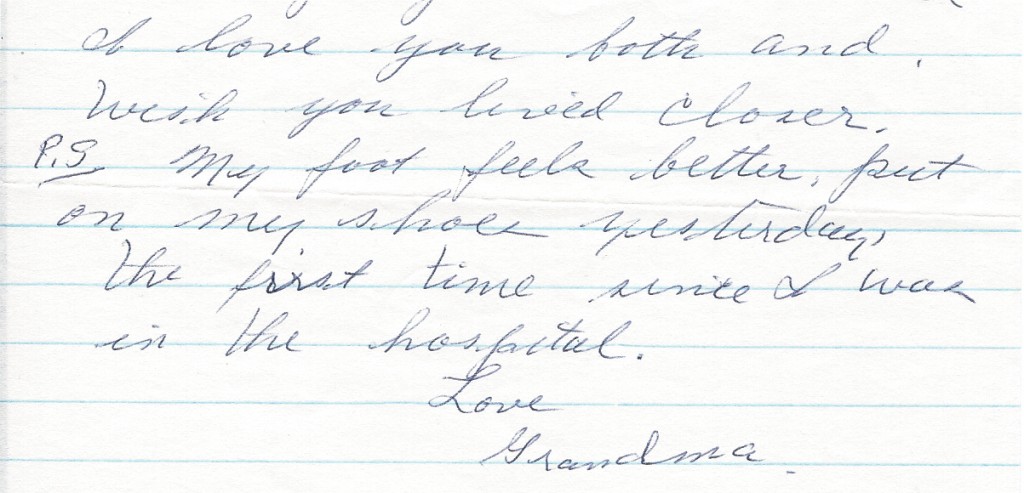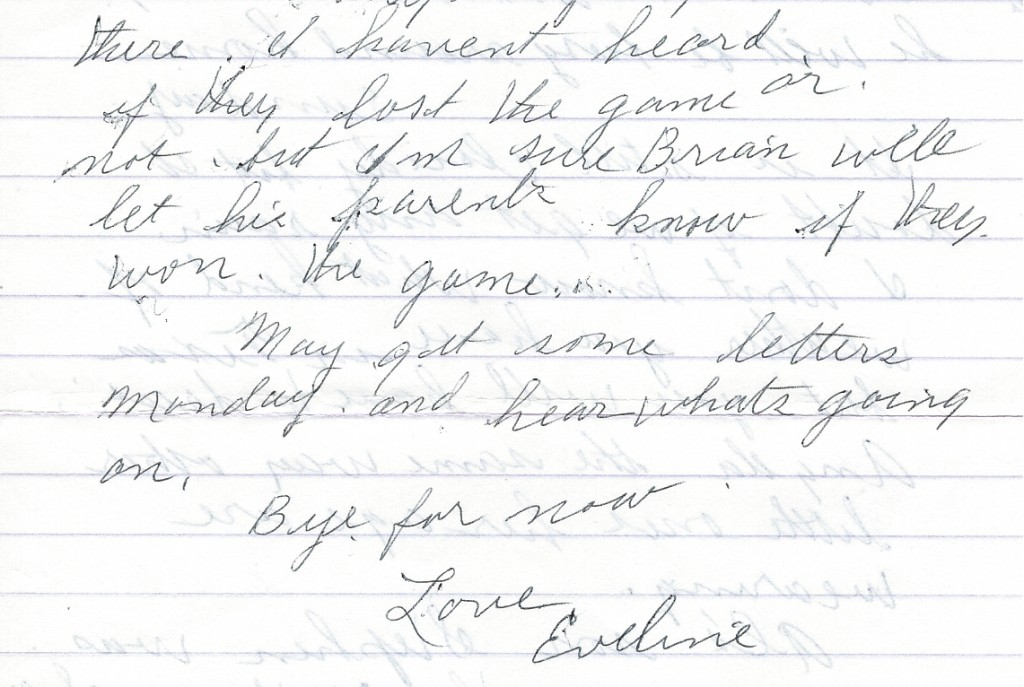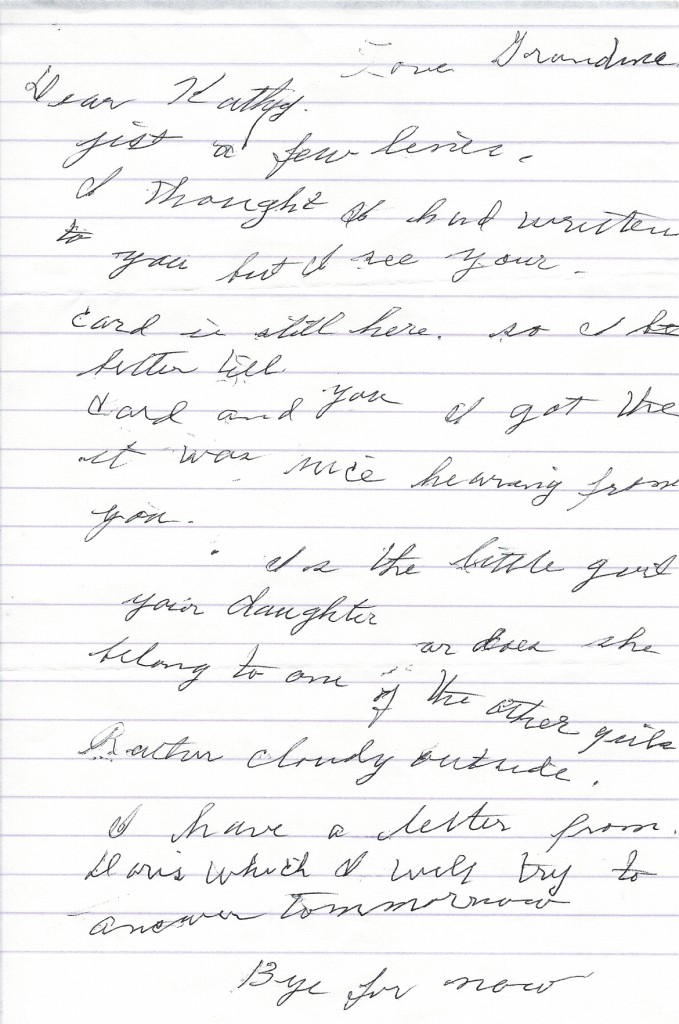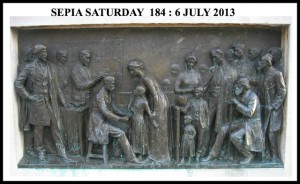I’ve been thinking a lot about handwriting recently because of the time I am spending with the Bryan Family Bible. In my most recent post about it, I made a case for identifying one of the writers as my 2nd great grandfather, George Washington Bryan.
Also, I’ve started “collecting” ancestor signatures. I got the idea from Jana Last at Jana’s Genealogy and Family History Blog, where she added a page for ancestor signatures and said she got the idea from another family history blogger. I love how we can steal share great ideas!
I haven’t added my ancestor signatures page to Abbie and Eveline yet because I only have a couple of signatures ready. I took a look at it this morning and realized I should add dates to those signatures before I publish them. So … I started looking at papers … and you know … got side-tracked … and so here I am deciding that I’ll spend a little time looking at how my grandmother’s handwriting changed over the years.
Because our handwriting does not stay the same over time.
In fact, sometimes mine changes in the same paragraph. I have a couple of different ways that I form some letters and, who knows why, but I’ll write the letter one way in one sentence and a different way in the next sentence. Sometimes my handwriting is really neat. Sometimes it’s sloppy. Sometimes the slant changes too – perhaps it has something to do with my mood?
It does make the identification of handwriting tricky.
I’m pretty good at identifying my grandmother Eveline’s handwriting. I was exposed to her writing for many years. But there are windows of time that her handwriting doesn’t look as I remember it.
Here are samples I might or might not recognize.


I don’t have a date on the above, but they are from a school paper – a book review of “The Mill on the Floss”. I’m thinking maybe she was about 17 years old. It is the earliest signature I can find among her papers. I might recognize the larger sample as hers, but maybe not the signature by itself.
Grandma signed a teacher contract in 1920. The capital E here isn’t anything like the one above! Maybe she was trying to demonstrate the cursive style that a teacher was expected to use at that time – wanting her bosses to know she could write like a teacher should.

By 1923, Grandma was married so, of course, her signature changed a bit then.

I don’t really have any writing samples that I can date as being in the 1940s-1950s, so I’ll skip to this sample from 1975 – a letter she wrote to my parents and sisters (I was already out of the house). It looks very familiar to me.

I am lucky to have quite a few letters that Grandma wrote to me. She would have written more if I had been better about writing to her! This sample is from December of 1983 and Grandma was a just couple of months away from her 84th birthday. When writing to me, she didn’t sign her name, of course….

… except when she began to age and those little mini-strokes began to chip away at her memory. Then she would sometimes sign her letters “Eveline” instead of “Grandma.” And she sometimes complained that her eyesight was dim.

As age and dementia marched on sometimes she wasn’t sure who I was, but she always answered my letters. Her handwriting became less like what it had been. This letter from March of 1987 is the last letter I have from her.

If all I had to go by were samples of handwriting from Grandma at age 17-20 and age 87, I don’t know that I would recognize them as being written by the same person.
But here they are. And I don’t have to guess. I know who wrote them.
 I didn’t intend to participate in Sepia Saturday this week. But, unlike most weeks, the prompt itself is a plaque rather than an old photograph. So I’ll stretch the prompt idea to include the words my grandmother put on paper – memorializing a bit of her life.
I didn’t intend to participate in Sepia Saturday this week. But, unlike most weeks, the prompt itself is a plaque rather than an old photograph. So I’ll stretch the prompt idea to include the words my grandmother put on paper – memorializing a bit of her life.
Please visit other Sepia Saturday participants and see what they have prepared for today’s prompt.


LOVE the idea for the “Ancestor Signatures” page! I am so blessed to have signatures from some of my more distant ancestors, and sharing it online is a wonderful idea!
Lauren
genejourneys.com
Yes – it’s a fun collection to begin – kind of a hobby within a hobby. And maybe it can serve a genealogical purpose as well.
Your grandmother’s handwriting did change over the years. I’m thinking I should go track some of my people’s writing. I love the way we get ideas from each other too.
It’s one of the best things about family history blogging. I learn so much from everyone and get so many new ideas.
What a lovely post, Kathy! I love the way you tracked your grandmother’s handwriting and related it to the different phases of her life. Sometimes I lament that my own handwriting suffers somewhat when I don’t wear my glasses – and can’t see what I’m writing. But as you so eloquently note, it’s not so much about the quality as just having something that your loved one wrote, especially when it was to you. Letters are like photographs of the heart.
What a lovely thought – Letters are like photographs of the heart. You are so right. Thanks for sharing that image.
Interesting project. I did the same for signatures by an ancestor in the mid- to late 1700s and early 1800s, and the writing and even spelling (!) changed a lot.
I’m hoping I can identify one or two more handwriting samples from the bible I mentioned. Not sure if I’ll be able to, but I’m going to give it try. And I’ve found that looking so closely at the writing has brought me other insights as well because I am really paying attention to what is there.
Wow, this is just wonderful. I have been known to spend hours in shops reading these kinds of letters and cards!
Thanks, Karen. Not what I would usually post for Sepia Saturday, but it’s what I’ve been doing lately. I am glad I have these letters.
Your Grandma’s handwriting in her letter to you looks so much like my Grandma J’s. I really like this post!
Kathy M.
Thanks, Kathy. I saw you commented somewhere else (now I’ve forgotten whose blog) that you are both Libras – me too.
Interesting post. I don’t have enough handwriting samples to analyze.
A touching essay on the evolving qualities of handwriting. I might add that styles change with the choice of fountain pen, pencil, or ballpoint. My own penmanship has changed over the years, and now I often discover that because I no longer write for any extended period, certainly not as much as I type, my hand aches and I must resort to a more sloppy quick scrawl. My uncle, who is 95, learned the Palmer method of penmanship and has always had a beautiful clear cursive. It is sad that the skill of handwriting is less valued now. Except for those of us collecting the ephemera of history.
You are right about the lack of practice and hand aches – I find it happens very quickly! My kids, who were taught cursive in school never use it and can barely read it.
I suppose our changing handwriting does chart our lives, but perhaps in the age where handwriting is becoming rarer, such timelines will be missing for future generations. One keyboard is very much like another.
And that delete button can easily erase what was typed. It will be interesting to see what will chart our lives in future generations – facebook status updates?
Very poignant Kathy, to see how the handwriting changed with age and dementia. Quite a collection you have there.
Thank you. It makes me happy to have these letters and more. Some are very special to me.
This was quite wonderful. It is true that writing changes as we age. Mine is now terrible thanks to arthritis and impatience. I have a friend who is in her 90s whose handwriting is so spectacular. She somehow manages to write in perfect beautiful lines across an unlined sheet of paper. Makes me so ashamed when I look at my chicken scratches.
I feel like I am out of practice and my handwriting has suffered. I keep thinking I’ll try to emulate my grandmother and start writing letters again, but it never seems to happen.
You are absolutely right, a person’s handwriting does change dramatically over time. Mine certainly has. And your grandmother, Eveline, is Exhibit A. Her capital E’s, as you point out, did “morph” through the years.
This summer my cousin and I were examining a set of memo books written by father and son over a span of 60-70 years in the 1800s. I say “father and son” because in the end we couldn’t tell which was which. We started with a theory that the father has a tighter, neater, more level handwriting, but by the time we finished looking at each of 20 memo books, our theory had reversed itself. We honestly couldn’t tell. At times we would say, “This is definitely the father’s handwriting,” only to discover the son had signed the passage. We ended with the weak hypothesis that they had learned cursive from the same teacher!
That is really interesting, Mariann. You would think that each would have developed somewhat of a personal style, even though taught the same cursive. Perhaps writing “correctly” was important, rather than the “personal style” that I anticipated I would develop in my own penmanship. It seemed almost a right of passage – learn to write in cursive as taught in school and then develop your style. I remember thinking of it as a sign of growing up – that I had my own unique handwriting – rather than conformity.
But there IS a connection — just as the bas relief tells a story, signatures can tell a story. You didn’t analyze loops and slants like a handwriting analyst would, but you showed how your grandmother’s signature told a story. I like the observations about your own handwriting because I saw my own habits too. I had beautiful penmanship until I went to college and had to take notes furiously. If someone traced my handwriting through the years, they might find Jekyll and Hyde.
Oh boy – those college notes. That would be something for someone to analyze. Especially the symbols I made up for frequently used words so I wouldn’t have to write them out. I substituted triangles and other shapes and my own abbreviations – no telling what some future descendant might make of it. 🙂
We have no examples of handwriting from our parents let alone our grand parents. We’d evev be pushed to find examples from our children. I do remember that my father had a beautiful copperplate script nut that’s all. Eveline’s writing definitely changed as she grew older. I wonder how today’s generation will get on with so much use of computers so little is wrriten by hand.
Since my kids did learn cursive, they did each develop a signature, but you can tell it seems awkward for them when they write it. The debate goes on about whether to spend time in school learning penmanship. I vote yes.
I vote yes, too! It’s almost like a personality trait!
And in turn, I’ll be stealing this idea here and use it in SS 187 with the prompt picture of old books.
The written word, whether published or not, famous or not…
I’ll use some of my mom’s letters to my father.
See, an idea goes a long way.
I too remember letters from my maternal grandma
and how it evolved over time.
She remained sharp until the very end,
but Parkinson affected her handwriting.
My own writing sure has changed from the time the Catholic nuns taught me to write
until now, as I scribble some gibberish. I was often told I wrote like a doctor,
which I’m not…
There are variations for some letters, depending on their position in a word,
whether they are at the beginning or the middle of said word.
I suspect my first grade teacher, Sister Jeanne, would go “Tsk, tsk!!!” upon seeing the way I write now
and slap my fingers with that big ruler of hers,
like she did back in the days,
unhappy she was when she realized I was ambidextrous;
she made sure I wrote ONLY with my right hand,
so I don’t follow into Satan’s footstep…
As if…
😀
HUGZ
Glad to be of help. I always say I steal some of my best ideas! My husband always talks about getting a “crock” across his hand with a 6-sided ruler from the Irish nun who taught him in elementary school. And no one can read his signature today!
Kathy, First of all, thank you for mentioning my blog and my ancestor signatures page. How sweet of you! What a great idea you’ve had to analyze your dear grandmother’s handwriting through the years. I can imagine the exercise was somewhat bittersweet though as you saw her handwriting change through the years due to age and dementia.
Yes – it was bittersweet. But it makes me very happy that we kept up our correspondence over the years. She was really the one who kept it going as I tend to leave things undone.
Kathy,
I want to let you know that your blog post is listed in today’s Fab Finds post at http://janasgenealogyandfamilyhistory.blogspot.com/2013/07/follow-friday-fab-finds-for-july-12-2013.html
Have a wonderful weekend!
Thanks, Jana!